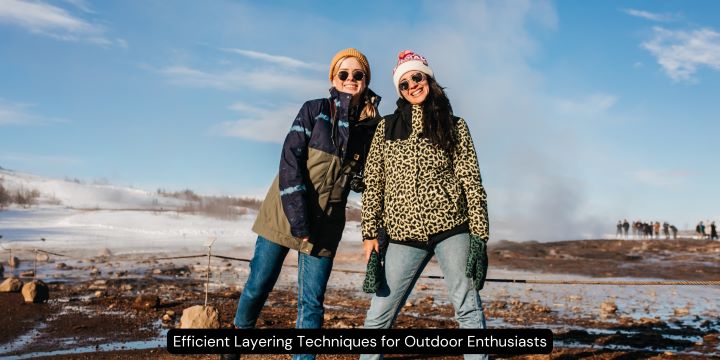Key Takeaways:
- Understanding the three-layer system for outdoor clothing.
- Choosing the right materials for comfort and function.
- Tips for managing temperature and moisture in varying climates.
When venturing into the great outdoors, whether it’s hiking up a mountain, skiing down slopes, or setting up camp in the wilderness, efficient layering is a skill that turns the journey from good to great. This crucial aspect of the outdoor gear array can significantly ensure comfort, warmth, and enjoyment throughout your escapade. Here is a comprehensive guide to layering, crafted to help you navigate the sometimes unpredictable conditions of the natural world.
Mastering the Art of Layering
Consider the art of layering as crafting your microclimate; it provides a reliable base from which you can adapt to any conditions nature throws at you. The principle behind layering involves using several garments that, when combined, will keep you warm, dry, and ready to face the elements. However, it is about more than throwing on more clothes; each layer serves a specific function, and choosing the incorrect type or weight can hinder your performance and overall outdoor experience. Knowing how to select appropriate base layers, insulating pieces, and protective shells is akin to learning the language of the wilderness—essential and empowering. For savvy adventurers looking to equip themselves without breaking the bank, scouting promo codes can effectively access high-quality layering pieces. But before you make any purchases, understanding how to create an effective layered system is key.
Base Layers: Your Second Skin
A base layer sits directly on your skin. It serves primarily to wick moisture away to keep you dry—a critical function since damp skin can feel uncomfortably cool and increase the risk of hypothermia in cold environments. Ideal base layers come in polyester, bamboo, silk, and merino wool, each with specific properties that lend themselves well to different seasonal conditions. Merino wool, for example, is renowned for its ability to regulate temperature and resist odors, while synthetics are often favored for their quick-drying capabilities. According to REI Co-op’s Expert Advice, a sound base layer keeps you dry and uses minimal seams to avoid chafing. It should fit snugly to maximize its moisture-wicking effectiveness.
The Insulating Layer: Trapping Heat Efficiently
The insulating layer plays a pivotal role in your comfort by retaining the heat your body generates. This layer generally consists of materials like fleece, down, or synthetic fills, which trap pockets of air to provide insulation. With its excellent warmth-to-weight ratio, Down is an ideal insulator for dry, cold conditions but loses its effectiveness when wet. Synthetics, however, provide a more reliable form of warmth in damp environments and continue to insulate even when damp. Balancing the level of insulation with mobility and weight is a juggling act that requires thoughtful consideration of the day’s activities and forecasted weather.
Outer Shell: The Protector
Your outer shell is the armor against wind, rain, snow, and whatever else the environment may present. Ensuring this layer is breathable, water-resistant, and effectively windproof can be the difference between comfort and misery. In recent advancements covered by sources, manufacturers continually innovate with materials that repel external moisture while allowing internal vapors to escape, keeping the wearer protected and less clammy. Additional features such as pit zips, adjustable cuffs, and storm flaps can help customize your exposure levels and regulate body temperature more effectively.
Accessorizing for Optimum Warmth
Though often overlooked, the correct accessories—gloves, hats, socks, and neck gaiters—play a significant role in overall warmth. Up to half of body heat is lost through the head and extremities, highlighting the importance of enclosing these areas in warm, breathable materials. These smaller items are also incredibly versatile, easily added or removed to adjust to thermal changes quickly. For example, a lightweight beanie can offer comfortable head warmth, while insulated gloves keep your fingers nimble for tasks like map reading or adjusting backpack straps.
Choosing the Right Accessories
Selecting the right accessories can harmoniously complement your layering system. Accessories should fit well, be suited to the trek’s conditions, and integrate seamlessly with your other layers. For instance, while gloves must offer the necessary warmth, they should also allow enough movement and grip for you to handle equipment without hindrance. Similarly, socks should be chosen based on the type of footwear and activity duration, with quick-drying and cushioned options optimal for long hikes.
Layering for Different Climates
The strategy for proper layering can shift dramatically with the climate. A desert hike requires light-colored, long-sleeved base layers that offer sun protection while facilitating cooling through evaporation. For alpine conditions, layering has to manage moisture despite colder ambient temperatures, necessitating layers that provide substantial insulation and robust wind and waterproofing. Adapting the layering principles accordingly is critical for maintaining a healthy core temperature across diverse environmental conditions.
Navigating Between Activities: Dynamic Layering
Switching between strenuous climbs and tranquil resting points or transitioning from trail walking to overnight camping demands layering versatility. This involves anticipating your body’s changing needs and modifying your attire to suit. Dynamic layering is a balancing act, where the key is to add or shed layers before overheating or getting too cold, respectively—a preemptive tactic that requires attention to your body’s signals and the weather patterns.
Adjusting Layers on the Go
Modulating your layers appropriately can significantly impact your comfort outdoors. Swiftly adapting to different stages of activity prevents excessive sweating during exertion and shivering when at rest. Zippable layers, button-up shirts, and vests provide options for easy on-the-move adjustments. Pack a compact, lightweight extra layer for unexpected weather changes or unplanned situations.
Handling Moisture Management
Efficient moisture management within your layered clothing is essential for ensuring comfort and safety outdoors. Neglecting this can result in fabric saturation, which feels uncomfortable and can lead to dangerous drops in body temperature. This is why the materials used for each layer should be selected with a view to moisture transport and evaporation. For intense pursuits such as skiing or mountaineering, fabrics with moisture-wicking properties and extra ventilation options can provide the necessary temperature regulation.
Materials That Keep You Dry
Layers made with materials that have a water-repellent finish or waterproof membranes are vital for keeping external wetness at bay. Such garments often come with features like taped seams, water-resistant zippers, and adjustable hoods, all of which can aid in managing different levels of moisture, whether from a passing shower or a severe downpour.
When to Adjust Your Layers
Understanding when to adjust layers to maintain thermal comfort is a crucial outdoor skill. Signs that it might be time to add a layer include a cooling body and goosebumps, indicating a drop in core temperature. Conversely, if you start feeling excessively warm or sweating, it’s time to shed a layer to avoid overheating. Introducing a breeze, changing altitude, or moving into shadowed areas are all environmental cues that may necessitate a layering adjustment.
Caring for Your Layers
Maintaining the effectiveness of your layering system extends beyond the thoughtful selection of each piece; it also depends on proper care. Wash your garments according to the instructions on each label, and repair small tears or worn areas before they become problematic. Clean and orderly storage away from direct sunlight and moisture will help your layers remain in top condition and ready for action.
Extending the Life of Your Gear
Quality outdoor gear is an investment that can last for years, provided it’s treated with care. By adhering to appropriate washing cycles, avoiding fabric softeners that can clog fabric pores, and correctly re-waterproofing when necessary, your gear can continue to offer peak performance. Storing layers flat or hung rather than tightly packed will help them retain their shape and insulation efficiency, ensuring they’re always ready for your next outdoor adventure.



